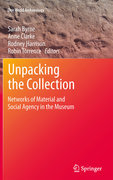
Unpacking the collection: museums as networks of material and social agency
Byrne, Sarah
Clarke, Anne
Harrison, Rodney
Torrence, Robin
Museums are a place to view art and artifacts and explain their archaeological and historical significance. As the contributions to this volume demonstrate, museums also provide a way to advance social theory. When a museum attendee looks at artifacts made by another culture – especially from an Indigenous culture—there is usually not much emphasis on how the objects were obtained, which was often as a result of war or colonization. Additionally, knowing where anobject is from can affect how the viewer reacts to the object, and the personwho made it. This particular two-tiered level of identity and agency (of the maker and the viewer) is unique to museums. In this innovative volume, the Editors take the opportunity of this cross-cultural interaction as a theoretical framework to examine materiality, agency, and identity. Grounded in case studies from individual objects and museum collections from North America, Europe, Africa, the Pacific Islands, and Australia, this truly international volume juxtaposes historical, geographical, and cross-cultural studies. This work will be of great interest to archaeologists and anthropologists studying material culture, as well as researchers in museum studies and cultural heritage management. Provides new theoretical framework for examining material culture International and cross-cultural case studies Features indigenous cultures not often the subject of mainstream research INDICE: INTRODUCTION. Chapter 1. Networks, Agents and Objects: Frameworks for Unpacking Museum Collections by Sarah Byrne, Anne Clarke, Rodney Harrison and Robin Torrence PROCESSES AND PERSPECTIVES. Chapter 2. 'Suitable for Decoration of Halls and Billiard Rooms': Finding Indigenous Agency in Historic Auction and Sale Catalogues by Robin Torrence and Anne Clarke. Chapter 3. ConsumingColonialism: Curio-seller's Catalogues, Souvenir Objects and Indigenous Agency in Oceania by Rodney Harrison. Chapter 4. Plumes, Pipes and Valuable: The Papuan Artefact Trade in South-West New Guinea, 1845-1888 by Susan Davies COLLECTORS AND NATIONHOOD. Chapter 5. Donors, Loaners, Dealers and Swappers: The Relationships behind the English Collections at the Pitt Rivers Museum by Chris Wingfield. Chapter 6. The Bekom Mask and the White Star: The Fate of Others’ Objects at the Musée du Quai Branly by Alexandra Loumpet-Galitzine. Chapter 7. Agency, Prestige and Politics: Dutch Collecting Abroad and Local Responses by Pieter ter Keurs COMMUNITIES AND COLLECTIONS. Chapter 8. Crafting Hopi Identities at the Museum of Northern Arizona by Kelley Hays-Gilpin. Chapter 9. Pathways to Knowledge: Research Agency and Power Relations in the Context of Collaborations Between Museums and Source Communities by Lindy Allen and Louise Hamby.Chapter 10. ‘Objects as Ambassadors’: Representing Nation through Museum Exhibitions by Chantal Knowles. Chapter 11. Seats of Power and Iconographies of Identity in Ecuador by Colin McEwan and Maria-Isabel Silva INDIVIDUAL COLLECTORS, OBJECTS AND 'TYPES'. Chapter 12. Hedley takes a Holiday: Collections from Kanak People in the Australian Museum by Jude Philp. Chapter 13. Death, Memory and Collecting: Creating the Conditions for Ancestralisation in South London Households by Fiona Parrot. Chapter 14. Trials and Traces: A. C. Haddon’s Agencyas Museum Curator by Sarah Byrne.
- ISBN: 978-1-4419-8221-6
- Editorial: Springer New York
- Encuadernacion: Cartoné
- Páginas: 200
- Fecha Publicación: 11/02/2011
- Nº Volúmenes: 1
- Idioma: Inglés
